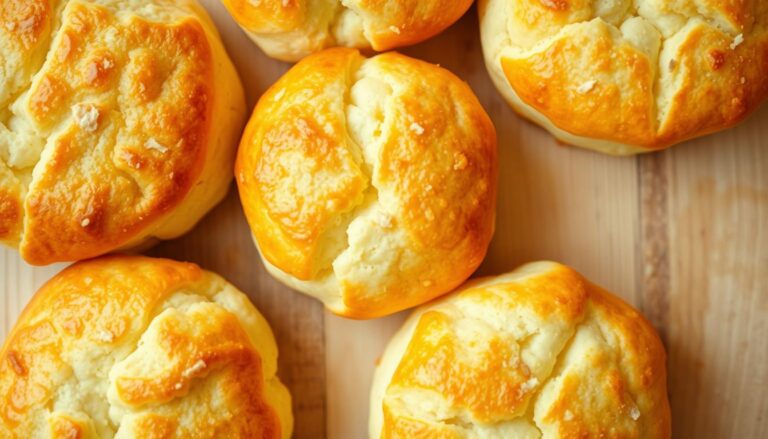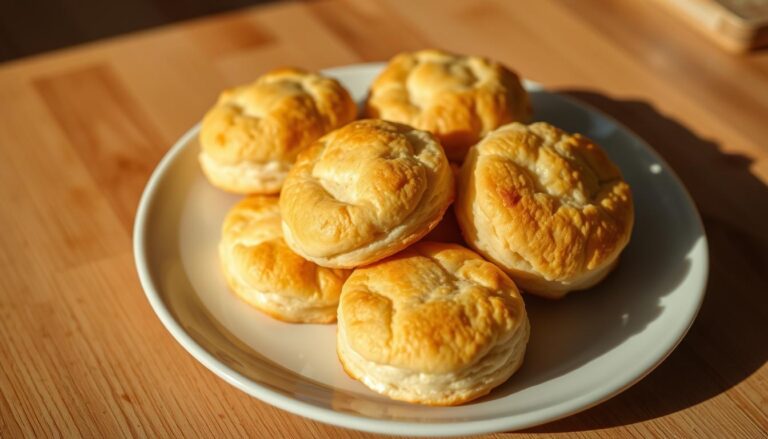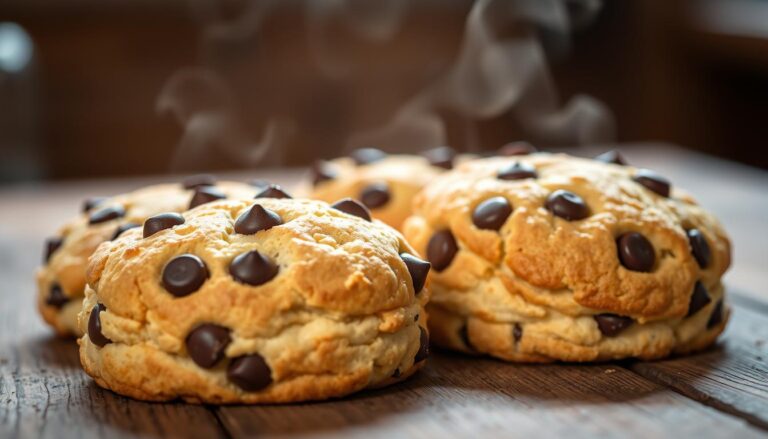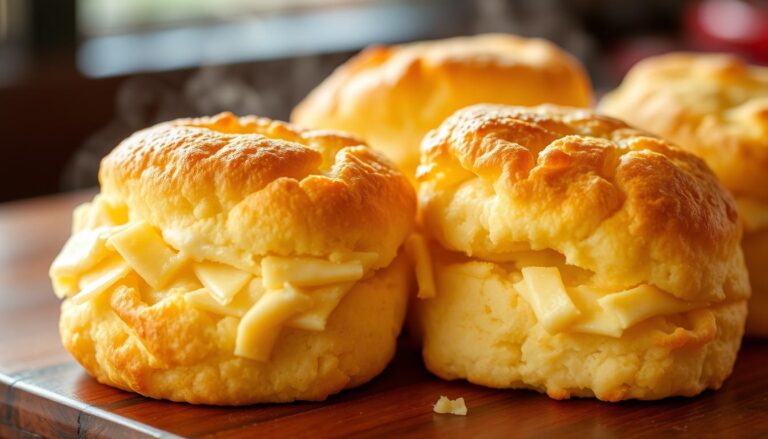Perfect Self Rising Flour Biscuits – Ready in 20 Minutes!
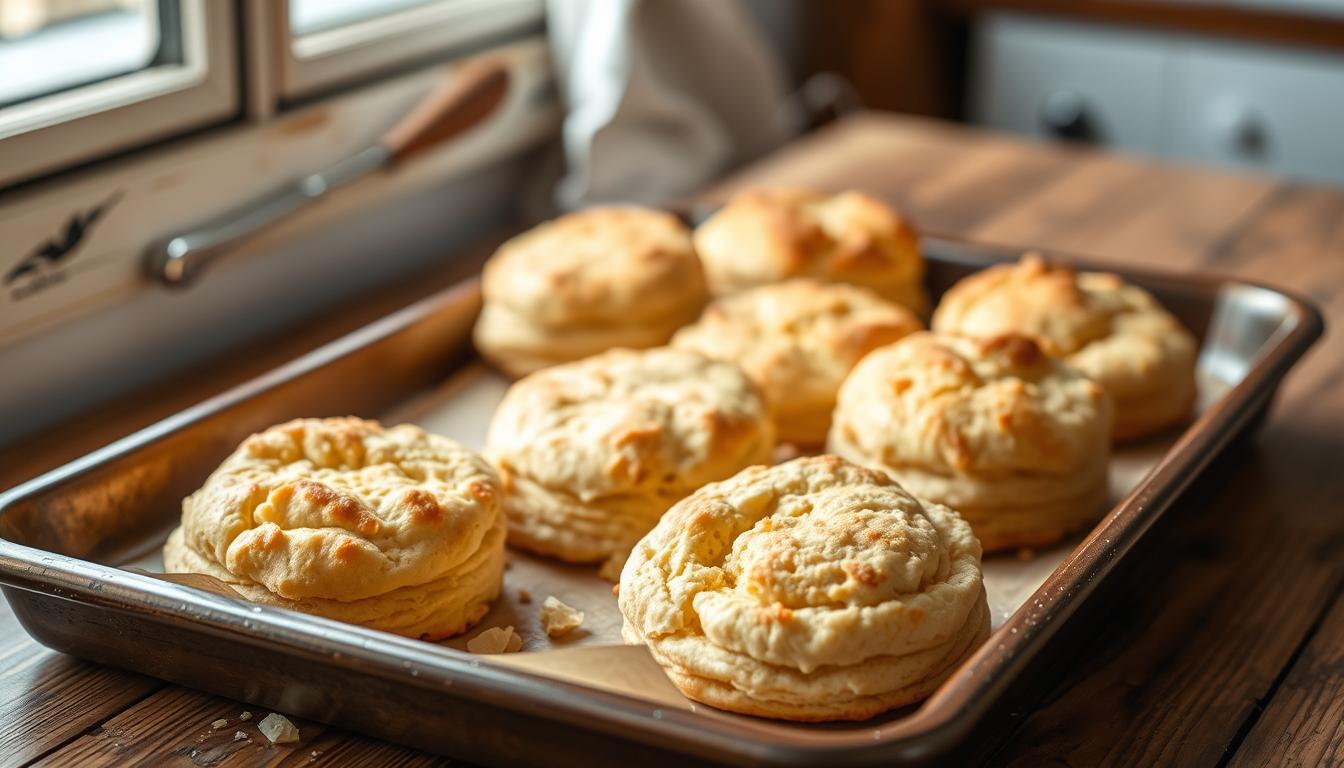
Growing up in a Southern kitchen, the smell of homemade biscuits was always a sign of comfort and love. My grandmother’s secret was a simple recipe for self-rising flour biscuits. It could turn any ordinary morning into something special.
Today, I’m excited to share a quick and easy biscuit recipe. It promises restaurant-quality results in just 20 minutes. Whether you’re busy or new to baking, these self-rising flour biscuits will become your favorite comfort food.
With just a few ingredients and minimal prep time, you can make golden, flaky biscuits. Your family will ask for seconds. No complicated techniques or fancy equipment needed – just pure, delicious simplicity.
Table of Contents
Key Takeaways
- Master a 20-minute self-rising flour biscuit recipe
- Create flaky, tender biscuits with just 3 ingredients
- Perfect for beginners and experienced bakers
- Minimal kitchen equipment needed
- Versatile recipe adaptable to various meals
Essential Ingredients for Perfect Self Rising Flour Biscuits
Making delicious baking powder biscuits starts with knowing the key ingredients. These ingredients turn simple flour into a Southern culinary treasure. Your biscuit success depends on choosing the right components that work well together.
The Role of Self-Rising Flour
Self-rising flour is the secret to Southern buttermilk biscuits. It combines all-purpose flour, baking powder, and salt. This mix makes your biscuits rise perfectly every time.
- Contains all-purpose flour
- Includes built-in baking powder
- Pre-measured salt for consistent flavor
Importance of Heavy Cream Selection
Choosing the right dairy is key for tender, flaky biscuits. Heavy cream with 36-40% fat content adds rich flavor and texture. Pro tip: Cold cream ensures maximum flakiness!
Additional Ingredients and Substitutions
While traditional Southern biscuits are classic, you can add your own twist. Here are some delightful variations:
- Add 1 cup shredded cheddar for cheesy biscuits
- Sprinkle dried herbs like thyme or rosemary
- Include 2 tablespoons sugar for sweet biscuits
“The secret to great biscuits is not just ingredients, but the love you put into making them.” – Southern Baking Wisdom
Baking is both science and art. Feel free to experiment with ingredients while keeping the basics of biscuit making in mind.
Kitchen Tools and Equipment Needed
To make delicious flaky biscuits, you need more than just good ingredients. The right kitchen tools can turn your biscuits into something special. Let’s look at the key equipment for making perfect self-rising flour biscuits.
Essential Baking Tools
- Large mixing bowl (ceramic or stainless steel)
- Measuring cups and spoons
- Biscuit cutter (2 1/2 inches in diameter)
- Baking sheet or cast-iron skillet
- Pastry cutter or two forks
For flaky breakfast biscuits, you’ll need precise tools. A heavy-duty mixing bowl gives you enough room for mixing. Accurate measuring tools help you get the same great results every time.
Recommended Equipment Breakdown
| Tool | Purpose | Recommended Type |
|---|---|---|
| Mixing Bowl | Ingredient combination | Large ceramic or stainless steel |
| Biscuit Cutter | Shaping biscuits | 2 1/2 inch metal cutter |
| Baking Surface | Baking biscuits | Preheated baking sheet or cast-iron skillet |
Professional bakers say quality tools are key for perfect biscuits. Invest in durable, reliable kitchen gear. It will improve your baking and make your biscuits flaky and delicious every time.
Pro Tip: Always keep your butter cold and your tools clean for the best biscuit results!
The Science Behind Flaky Biscuit Layers
Making fluffy biscuits is an art that needs scientific precision. It’s about how ingredients mix to create tender layers that feel like a cloud. Chefs know every step is crucial to turn simple ingredients into a masterpiece.
Temperature is key to getting those flaky layers. Restaurants keep ingredients cold to ensure the right rise. This careful control stops gluten from forming too fast, keeping your biscuits soft.
Understanding Gluten Development
Gluten is crucial for biscuit texture. Here’s what you need to know:
- Minimal handling prevents excessive gluten formation
- Cold ingredients help maintain a tender crumb
- Gentle mixing preserves biscuit softness
Temperature Control Techniques
Professional bakers use smart temperature tricks:
- Chill butter for about 15 minutes before using
- Keep ingredients around 41°F
- Use quick, light mixing techniques
The Role of Steam in Rising
Steam is the magic behind flaky layers. When cold butter melts in the oven, it creates steam. This steam pushes the dough up, making your biscuits rise beautifully. Bakers often bake at 350 degrees Fahrenheit for a slow rise and soft layers.
“The magic of biscuit making lies in understanding the delicate dance of ingredients and temperature.” – Professional Baker’s Wisdom
By learning these scientific biscuit-making tips, you can make restaurant-quality biscuits every time.
Step-by-Step Mixing Method
Making the perfect easy biscuit recipe needs careful mixing. Start your journey to tasty homemade biscuits by learning how to mix ingredients right.
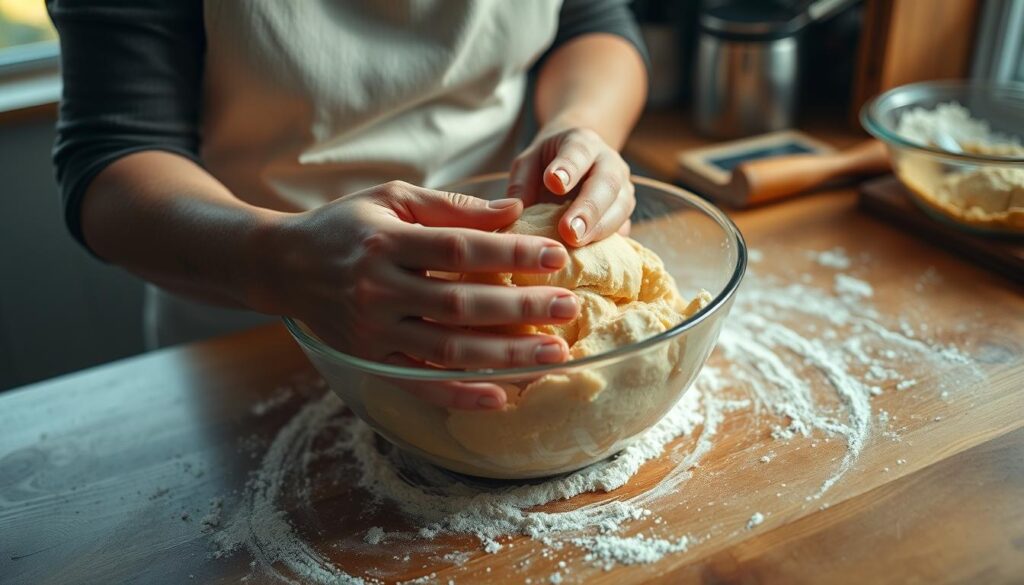
First, gather your ingredients for making simple homemade biscuits. Make sure all ingredients are cold for the best texture and rise.
- Measure 2 cups of self-rising flour into a large mixing bowl
- Add 6 tablespoons of cold shortening
- Use a pastry cutter or fork to blend ingredients
Pro tip: Cut the shortening into the flour until the mixture resembles coarse pea-sized crumbs. This step is key for flaky layers in your easy biscuit recipe.
| Mixing Stage | Key Action | Time Estimate |
|---|---|---|
| Flour Preparation | Sift and measure | 2-3 minutes |
| Fat Incorporation | Cut shortening into flour | 3-5 minutes |
| Liquid Addition | Slowly mix buttermilk | 1-2 minutes |
When adding liquid, use 3/4 cup of cold buttermilk. Stir gently until the dough just comes together. Remember: Overmixing is the enemy of tender biscuits! Aim for a slightly shaggy dough that will turn into light, fluffy homemade biscuits.
The secret to perfect biscuits is minimal handling and keeping ingredients cold.
Proper Dough Folding Techniques
Mastering biscuit making is all about dough folding. It’s a delicate process that turns simple ingredients into flaky, buttery treats. You need a gentle touch and precise technique.
Creating Multiple Layers
The secret to flaky biscuits is in the folding. You want to create layers without overworking the dough. Here’s how to do it:
- Gently pat the dough into a rectangle
- Fold the dough over itself 3-4 times
- Use light, minimal touches to prevent gluten development
- Aim for visible butter streaks in the dough
Handling Delicate Dough
Biscuit making is all about balance. Your hands are crucial for creating tender, flaky layers. Keep these tips in mind:
- Use cold ingredients to maintain butter’s integrity
- Work quickly to prevent butter from warming
- Touch the dough as little as possible
Pro tip: Cold butter is the key to achieving those signature flaky biscuit layers!
Remember, practice makes perfect in biscuit making. Each fold adds to the layers that make homemade biscuits special.
| Folding Technique | Layer Result |
|---|---|
| 1-2 Folds | Minimal layers |
| 3-4 Folds | Optimal flaky texture |
| 5+ Folds | Potential tough biscuits |
By mastering these techniques, you’ll improve your biscuit making skills. You’ll make flaky biscuits like a pro every time.
Cutting and Shaping Your Biscuits

Making southern biscuits needs careful cutting and shaping. The right way can make your breakfast biscuits truly special.
Use a sharp biscuit cutter for clean cuts. Here are some tips for cutting your biscuits:
- Press the cutter straight down without twisting
- Use a swift, confident motion
- Avoid dragging or rotating the cutter
Where you place your biscuits matters. Put them close together on the baking sheet. This helps them rise better and get a soft, golden outside.
For biscuits that look great, remember these tips:
- Lightly flour your cutting surface
- Pat the dough to a consistent 1-inch thickness
- Re-roll scraps gently to avoid tough biscuits
- Use a 2.5-inch round cutter for classic southern biscuits
Handling the dough gently is important. You want to keep the flaky layers you worked so hard to make. This way, your biscuits will be a hit at breakfast.
Baking Temperature and Timing Guidelines
Mastering baking powder biscuits needs precision in temperature and timing. The last moments in the oven can make your dough fluffy or disappointing.
Optimal Oven Settings
Your success starts with the right oven temperature. Experts say to preheat to 450°F for perfect biscuits. This heat is key for those fluffy biscuits everyone loves.
- Preheat oven to exactly 450°F
- Use a reliable oven thermometer for accuracy
- Position rack in the center of the oven
Visual Cues for Doneness
Knowing when your biscuits are done is crucial. Look for these signs of a well-baked batch:
- Golden-brown tops with a slight shine
- Edges that are crisp and lightly bronzed
- Slight expansion and rise in the biscuit height
Baking time is usually 8 to 10 minutes. Watch closely in the last minutes to avoid over-browning. Your biscuits should come out puffy, golden, and very tempting.
Storage and Reheating Methods
Making perfect homemade biscuits is an art. But knowing how to store and reheat them is key to enjoying them longer. Your freshly baked breakfast biscuits need the right care to keep their great taste and texture.
Storage Guidelines
Here’s how to store your delicious homemade biscuits:
- Room temperature storage: Up to 3 days in an airtight container
- Refrigerator storage: Extends shelf life to 1 week
- Freezer storage: Preserves biscuits for up to 6 months
Reheating Techniques
Here are easy ways to reheat your breakfast biscuits:
- Oven method: Preheat to 350°F, warm for 6-7 minutes
- Microwave option: Heat for 30 seconds
Freezer-stored biscuits? Let them thaw at room temperature first. For oven reheating, frozen biscuits need 10-15 minutes to warm up right.
Nutritional Preservation
Storing biscuits right keeps their nutritional value. Each biscuit has about 78 calories, 12g carbs, and 5g protein. Store them carefully to keep these nutrients.
Troubleshooting Common Biscuit Problems
Biscuit making can be tricky, even for experienced home bakers. Knowing the common challenges helps you make fluffy biscuits every time. Let’s look at some common issues you might face.
Height Challenges in Biscuit Baking
Flat biscuits can be frustrating for any baker. Several factors affect biscuit height:
- Old or expired leavening agents reduce rising potential
- Twisting the biscuit cutter can seal the edges, preventing proper rise
- Overworking the dough destroys delicate air pockets
To achieve fluffy biscuits, handle the dough gently and use fresh ingredients. Always cut straight down with your biscuit cutter to maintain those crucial air channels.
Texture Troubleshooting
Texture problems can make your biscuits less enjoyable. Common texture issues include:
- Tough biscuits: Result from overmixing the dough
- Dense biscuits: Caused by compressing the dough too much
- Dry biscuits: Often from using too little fat or liquid
The key to perfect biscuit making is understanding ingredient interactions and treating your dough with a light touch. Minimal handling helps maintain the tender, flaky texture bakers desire.
Pro tip: Cold ingredients and quick mixing are your best friends in creating exceptional biscuits!
Conclusion
Your journey to making perfect self-rising flour biscuits is now over. This easy recipe guides you to making delicious, fluffy biscuits. They can make any meal better. With a few simple ingredients and the techniques you’ve learned, you can impress everyone.
Self-rising flour biscuits are easy and versatile. They’re great for a quick breakfast or to go with a big dinner. The pre-measured leavening in self-rising flour makes baking easy and removes the need to guess ingredient amounts.
Remember, practice makes perfect. Every time you bake these biscuits, you’ll get better. Feel free to try new things to make this recipe your own. Your kitchen is ready to make bakery-quality biscuits in no time.
Enjoy your baking journey and relish every flaky, tasty bite of your homemade self-rising flour biscuits!
FAQ
What is self-rising flour, and why is it special for biscuits?
Can I make self-rising flour at home if I don’t have it?
What’s the secret to getting really flaky biscuits?
How do I prevent my biscuits from turning out tough?
Can I freeze biscuit dough for later?
What’s the best way to reheat leftover biscuits?
Can I use buttermilk instead of heavy cream?
How do I know when my biscuits are done baking?
Leave a review :
There are no reviews yet. Be the first one to write one.

